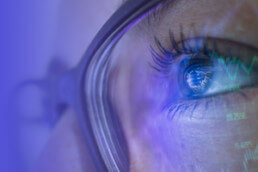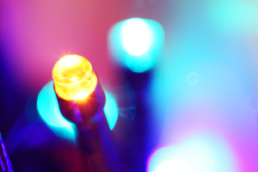Using Light Exposure to Combat the Post-Lunch Dip
For years, researchers have known that exposure to certain wavelengths of visible light helps prevent production of melatonin, a chemical responsible for drowsiness. Short wavelength blue light striking the retina is known to suppress the production of melatonin, while long wavelength red light has no effect on melatonin production. A circadian rhythm is a 24-hour biological cycle responsible for regulating sleep. Limiting exposure before bedtime to blue light can alter one’s Circadian rhythm.
Past research has shown that subjects who wore goggles that block blue light from their eyes in the hours before sleep, had significantly improved their sleep quality as well as their mood.
RPI studied the effects of red and blue light exposure on attentiveness.
The team at RPI set out to determine if exposure to long wavelength red light, which is not associated with melatonin suppression, could also provide people with a feeling of alertness during daylight hours. Participants received blue or red light exposure for 48 minutes at an illumination of 40 lux.
After each exposure, an electroencephalogram (EEG) measured the theta, alpha theta, and alpha brainwaves. These brainwaves measure deep relaxation and sleepiness.
The result that red light, which does not suppress melatonin production, is still effective in lowering the power of alpha, alpha theta, and theta brain waves. This indicates that the red light was able to increase alertness and decrease drowsiness in the test subjects. The research data shows that light can have an alerting effect during daylight hours even without suppressing the production of melatonin in the brain.
More recent studies conducted at University of Washington School of Medicine (UW) also supports the idea of lighting and its role in sleep patterns, alertness, and mental acuity. Prior studies have reviewed how lightness and darkness can play a role in circadian cycles but in 2020 UW uncovered the additional role the eye’s natural circadian color system plays. UW acknowledges existing blue light research and its impact on the sensitivity of a pigment in the eye known as melanopsin but takes it a step further by stating that the cone photoreceptors are much more sensitive to light than melanopsin. Uncovering that these receptors react to similar colors found in sunrise and sunsets (orange and yellow wavelengths and contrasting light) provided insight on how these changes in color impact our internal clocks. In the research, an amacrine cell located in the retina identified a signaling to photosensitive ganglion cells that directly affects our internal circadian cycles.
A lighting company TUO is currently producing and selling LED lightbulbs using this technology that mimics sunrise and sunset wavelengths for use in the commercial market. Their research in conjunction with UW focuses more on the sensitivity to changes in the color of light and its impact on circadian rhythms.
Illuminance Color Meters from Konica Minolta measure photometric brightness and also provide detailed color information for light readings. These color meter include:
Konica Minolta Sensing’s CL-500A compact illuminance spectrophotometer convenient measurement functions include continuous measurement mode, display of the averaging of multiple measurements, delayed-measurement function, and the display of data at a specific wavelength. The CL-500A measures illuminance, color temperature, CRI (Color Rendering Index), chromaticity, and spectral power distribution. In addition, the CL-500A displays the S/P ratio of scotopic illuminance and photopic illuminance.
Konica Minolta Sensing also offers a CL-70F portable spectrometer based illuminance meter that accurately measures color temperature, illuminance, and color rendering index. A high-resolution CMOS sensor captures the spectral power distribution of light sources including LEDs, HID, Halogen, and OLEDs. The CL-70F is designed to distinguish CRI, or color rendering index, and spectral data, conserving energy and improving the quality of light in your required space.
When determining the accuracy of an LED s illumination, color temperature measurements are particularly important. This instrument utilizes sensors that closely parallel the color-matching functions specified by the International Commission on Illumination (CIE). Depending on the application for which the CL-200A is used, results can be displayed through different color notations.
Visit our lighting industry page and learn more about Konica Minolta Sensing’s line of lighting and display measurement.
Source:
Phys.org “Let there be ‘circadian’ light: New Study Describes Science Behind Best Lights to Affect Sleep, Mood and Learning”
Thetuolife.com
www.news.rpi.edu “Morning Blue Light and Afternoon Red Light Increases Alertness in Office Hours”










